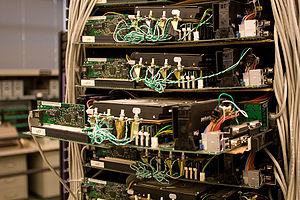- Computer History Museum
-
 A Cray-2 supercomputer at the Computer History Museum
A Cray-2 supercomputer at the Computer History Museum
The Computer History Museum is a museum established in 1996 in Mountain View, California, USA. The Museum is dedicated to preserving and presenting the stories and artifacts of the information age, and exploring the computing revolution and its impact on our lives.
Contents
History
The museum's origins date to 1968 when Gordon Bell began a quest for a historical collection and, at that same time, others were looking to preserve the computer Whirlwind. The resulting Museum Project had its first exhibit in 1975; located in a converted coat closet in a DEC lobby. In 1978 the museum, now The Digital Computer Museum (TDCM), moved to a larger DEC lobby in Marlboro, Mass. Maurice Wilkes presented the first lecture at TDCM in 1979 – the presentation of such lectures has continued to the present time.
TDCM incorporated as The Computer Museum (TCM) in 1982. In 1984 TCM moved to Boston, locating on Museum Wharf.
In 1996/1997 The TCM History Center (TCMHC) in Silicon Valley was established; a site at Moffet Field was provided by NASA (an old building that was previously the Naval Base furniture store) and a large number of artifacts were shipped there from TCM.
In 1999 TCMHC incorporated and TCM ceased operation, shipping its remaining artifacts to TCMHC in 2000. The name TCM had been retained by the Boston Museum of Science so, in 2000, the name TCMHC was changed to Computer History Museum (CHM).
In 2003 CHM opened its new building (previously occupied by Silicon Graphics), at 1401 N. Shoreline Blvd in Mountain View, California, to the public.[1][2]
Current
The Computer History Museum claims to house the largest and most significant collection of computing artifacts in the world (the Heinz Nixdorf Museum, Paderborn, Germany, makes similar claims[3]). This includes many rare or one-of-a-kind objects such as a Cray-1 supercomputer as well as a Cray-2, Cray-3, the Utah teapot, the 1969 Neiman Marcus Kitchen Computer, an Apple I, and an example of the first generation of Google's racks of custom-designed web servers.[4] The collection comprises nearly 90,000 objects, photographs and films, as well as 4,000 feet (1,200 m) of cataloged documentation and several hundred gigabytes of software.
The museum's 25,000-square-foot (2,300 m2) exhibit "Revolution: The First 2000 Years of Computing," opened to the public on January 13, 2011.[5][6][7]
The museum has two additional exhibits highlighting important milestones from the history of computing: "Mastering the Game," a history of computer chess and a Difference Engine designed by Charles Babbage in the 1840s and constructed by the Science Museum.
Former media executive John Hollar was appointed CEO of The Computer History Museum in July 2008.
See also
- Vintage Computer Festival held annually at The Computer History Museum
- Computer museums
- History of computing
- History of computer science
Notes and references
- ^ Bell, Gordon (2011).
- ^ Backgrounder Press release on the Computer History Museum
- ^ Heinz Nixdorf Museum
- ^ How Google Works David F. Carr, Baseline.com, July 6 2006
- ^ Wollan, Malia (2011-01-13). "Computer History Museum Unveils Its Makeover". The New York Times. http://www.nytimes.com/2011/01/14/us/14museum.html?_r=1.
- ^ Bilton, Nick (2010-01-14). "Bits Pics: The Computer History Museum". The New York Times. http://bits.blogs.nytimes.com/2011/01/13/bits-pics-the-computer-history-museum/?ref=technology. Retrieved 2011-01-15.
- ^ "Computer History Museums Major New Exhibition Opens January 12th 2011". Computerhistory.org. http://www.computerhistory.org/press/revolution-opening.html. Retrieved 2011-01-15.
Further reading
- Bell, Gordon (2011). Out of a Closet: The Early Years of the Computer [x]* Museum. Microsoft Technical Report MSR-TR-2011-44.
External links
- Computer History Museum website.
- Computer History Museum videos.
- Catalog Search - Search for the museum collections
- WAVE report on the Computer History Museum, with many photographs of interesting artifacts. Note: many links on this site do fail because their letter case does not match that of the destination file. Try altering the URL to access the file's directory instead.
Other photographs from the Computer History Museum
-
Cray-1 near the Visible Storage room
Coordinates: 37°24′52″N 122°04′37″W / 37.414371°N 122.076817°W
Categories:- Visitor attractions in Silicon Valley
- Museums established in 1996
- Mountain View, California
- Computer museums in California
- Museums in Santa Clara County, California
Wikimedia Foundation. 2010.









